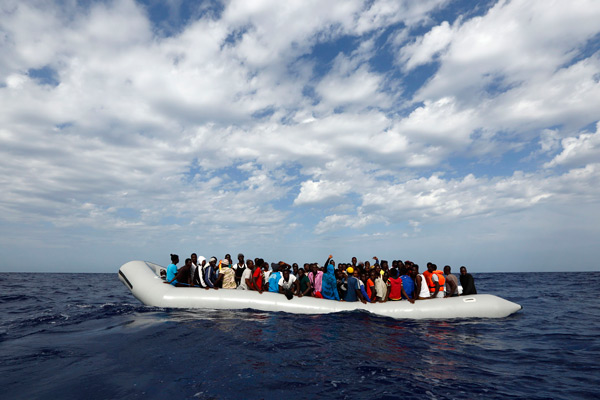The European Asylum Support Office: a dialogue with the Spokesperson Jean-Pierre Schembri
Following our first article on the structure and main tasks of the European Asylum Support Office, we interviewed Jean-Pierre Schembri, Spokesperson of the EASO, to satisfy our and many other people’s interest.
Asylum Corner: Due to the primary importance of asylum issues in today’s European politics, the European Asylum Support Office (EASO) keeps strengthening its role and visibility among the EU agencies. In a nutshell, what is the overall role of the EASO?
Jean-Pierre Schembri: The European Asylum Support Office is the European center of expertise in the area of asylum and our main aim is to support Member States within the Common European Asylum System. We have a number of tools at our disposal, which enable us to achieve our goals. I’ll provide some examples.
First, we offer training, since we believe that if all asylum and reception officers go to the same school and have the same material to work on, they will be more likely to come to the same conclusions. Our main aim is to have a Common European Asylum System, which means that similar cases are given similar treatment and give similar outcomes. Until today, we have trained over 6.200 asylum officials.
Then we work on Early Warnings and Information Analysis that means collecting information and conducting analyses of the asylum trends every month. Our Monthly Report (together with the Quarterly Report and the Annual Report) is fundamental for officials, policy-makers and citizens to have an idea of what is going on.
Moreover, we offer Special, Emergency and Operational Supports to Member States who experience great pressures on their borders. We have been active in six Member States and we currently have ongoing missions in Italy, Bulgaria, Cyprus and Greece
We are also involved in the External Dimension of the Common European Asylum System (CEAS) and, for that, we have some projects going on right now. A few weeks ago, for example, we held a seminar at the Moroccan Parliament since it is soon to discuss a new asylum law for Morocco. So, before this discussion started, we thought that it was necessary to familiarize them with the European Asylum System and so we organized a seminar addressing it. We also have similar ongoing projects in Jordan and Tunisia.
Finally, the work the EASO does in the field of Country of Origin Information (COI). We are quite active in this area and we issue COI reports on a number of countries like Somalia, Chechnya, Afghanistan and the Western Balkans. These reports help asylum officials to make their decisions when deciding whether to grant asylum or not. We also have a common European portal, where COI reports are filed and are available to all European asylum officials; the portal will hopefully become publicly available, we are currently working on that. So, in a nutshell, I would say these are the main tools we have to pursue our goals.
A-C: I want to jump back to the training issue for a moment. How does the training work? Do you train directly the people that are operative in the Member States or is it more an indirect training?
S: We mostly use the “train the trainers” system. Our modules are divided in two sections, namely an online part and a face-to-face section. However, some Member States have such small asylum systems that they do not have their trainers, so in that case we call the actual officers to participate in our training.
A-C: Which are the categories that generally participate the most in the EASO Trainings?
S: Generally, asylum officers who examine the cases, and also reception officers, who are those working in the reception centers. We also have an ongoing program with the judiciary and lately, we have been also receiving some requests from academics; in these latter cases, we usually take them on a one-to-one basis and sometimes we let them participate in our trainings.
A-C: Let’s move on to Operational Support, which is a major help you provide to countries under pressure. How does it work in practice? Is it a consultancy relationship or do you provide guidance to the officials involved?
S: I would say it’s a mix. Sometimes we work as consultants, as in the case of Bulgaria on the issue of EU funds absorption. Other times, we provide training work in a case of emergency, where a lot of people need to be recruited and trained very fast. In Italy for example, the judiciary needed to be trained. In another case, a particular COI was needed and we swiftly provided that.
We have asylum support teams, which we deploy to the Member States when needed.
A-C: About the External Dimension, how does the EASO work to keep fundamental rights as a priority when working with countries such as Morocco, Tunisia and Jordan?
S: Of course our aim in the External Dimension is to strengthen the asylum and reception capacity of Third Countries in order to protect asylum seekers. We obviously cannot dictate our laws and ways of working. But, for example, we can introduce our best European practices, as we did in Morocco, and it’s also proving to be well accepted by Third Countries, at least from the feedback we are getting on the field, which is very positive.
Of course in the future, we plan to widen our work to Third Countries but for now our capacity is very small. Our staff includes 86 people and we work with 28 Member States, so it’s not too easy to work with Third Countries as well. Furthermore, in this moment there are some countries with which it’s quite difficult to work, as witnessed by the situation of tensions in our immediate neighborhood. Given this context we are still managing to do our part and it’s proven by the fact that we are involved with a number of countries, in particular Morocco, Jordan, Tunisia, but also Turkey for example.
A-C: In the press release issued on the occasion of Commissioner Avramopoulos’ visit to the EASO offices in Malta, the Joint Processing Pilot conducted in 20 Member States was presented. Could you please tell us a little more about what these Joint Processing Pilots[1] are?
S: The area of Joint Processing is a new area that we are currently exploring ourselves. Up to now, we have worked in 20 countries to try to introduce this specific element of joint processing. Something we have seen is that there are new levels of trust between the Member States involved, and it’s amazing that when they started working together it became more and more obvious that we are not that dissimilar and the techniques which are used in one Member State are actually very similar to those that are used in other Member States. So, people used to believe that on the other side of the border things were done differently, but this has proven not to be the case. Now we are in the second phase of this pilot project and we recently led an activity in the Netherlands, which also saw the participation of Swedish and Belgian experts. Therefore, we are continuously trying to explore this area but you can understand that it’s a very sensitive area since it entails strong political decisions. However, it seems to be working and it seems that the demand for it could increase as well.
A-C: One last question about the communication strategy of the European Asylum Support Office. It looks like the agency is opening up a lot towards different point of views coming from civil society about asylum, through tools like, for example, the Consultative Forum.
S: Yes, it is indeed in our interest to get the perspective of civil society organizations working in the field of asylum since they are generally quite well equipped, they have expertise in particular areas of the subject — which are quite difficult to find — and therefore it is beneficial for us to have them on board.
[1] Joint Processing is “an arrangement under which all asylum claims within the EU are processed jointly by an EU authority assuming responsibility for both preparation and decision on all cases, as well as subsequent distribution of recognized beneficiaries of international protection and return of those not in need of protection (Study on the Feasibility and legal and practical implications of establishing a mechanism for the joint processing of asylum applications on the territory of the EU, European Commission, 2013)




